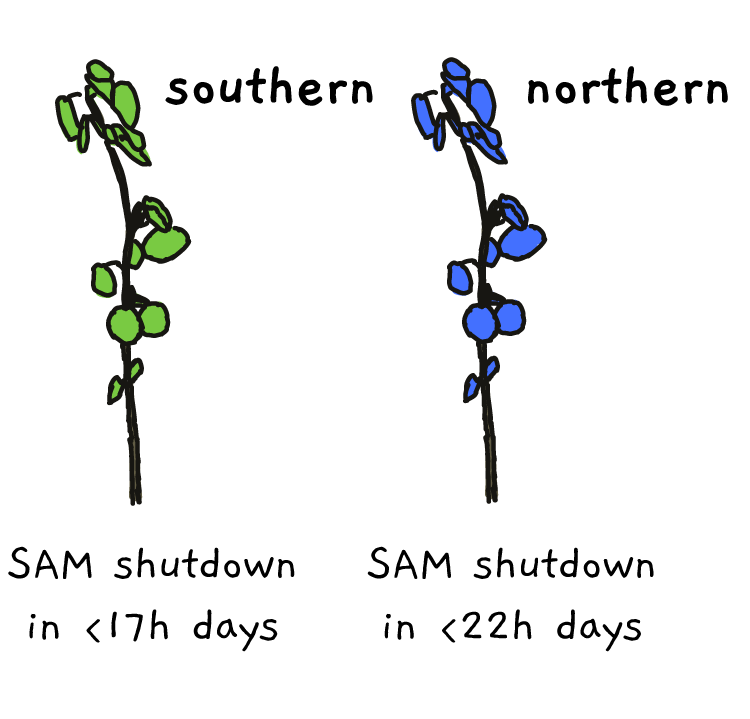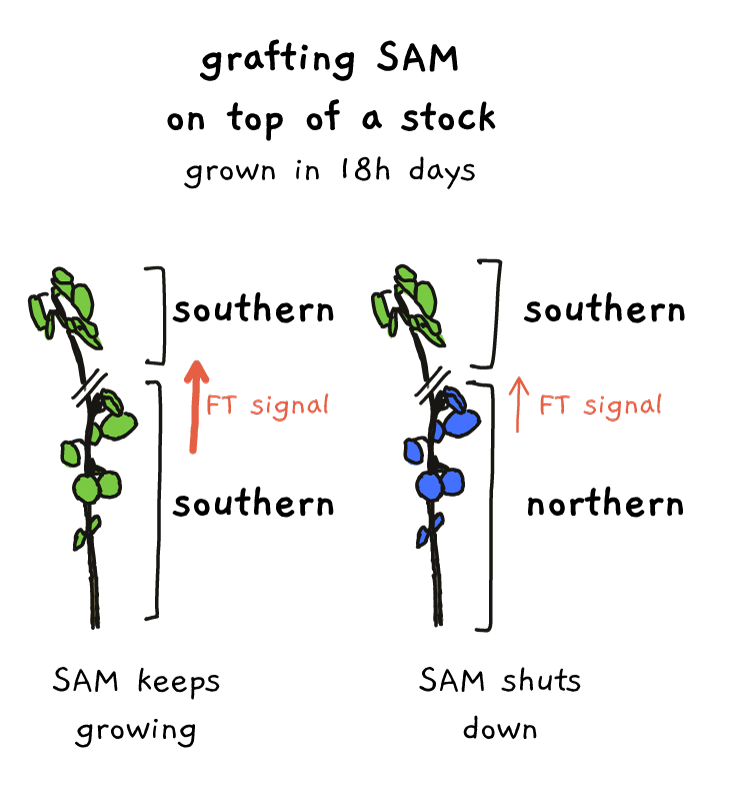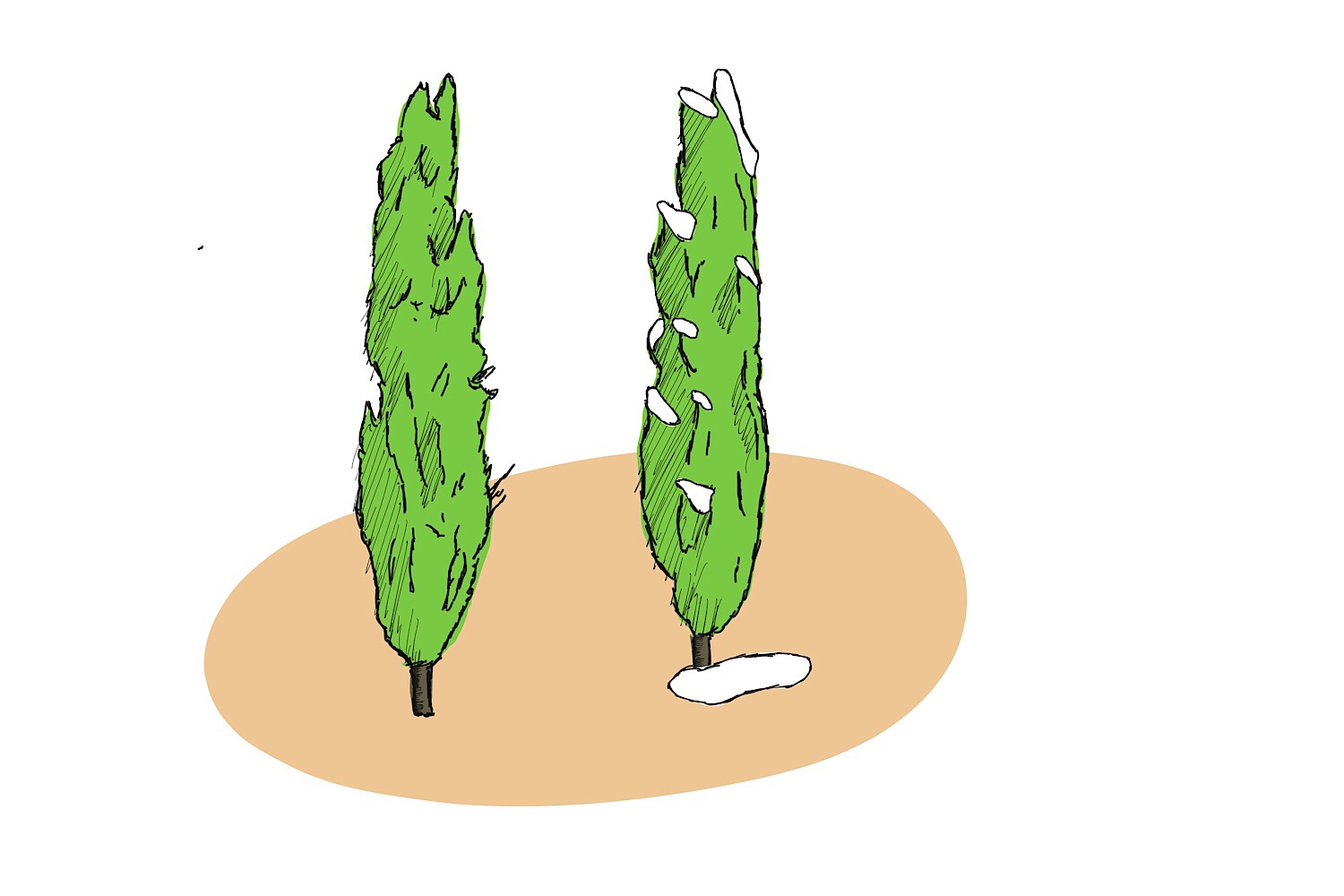Winter time can be hard for plants, and many species that live in particularly cold climates do their best to ‘opt out’. When autumn comes, leaf shedding deciduous species effectively shut it all down. They reabsorb as many nutrients as they can from their leaves, throw the remaining orange-red husks to the ground, and hunker down for the cold times.
Evergreen trees, like pines and spruces, aren’t quite as dramatic. But they still need to find ways to protect themselves and their most valuable assets from the killer cold.
The most precious part of most plants is the shoot apical meristem (aka SAM), a small clump of cells from which leaves and flowers differentiate. Before winter gets too rough, the plants signal their SAM to stop growing, and start developing a bud-like structure around the SAM, which effectively blankets it from the cold.
One factor likely involved in this SAM Shutdown Signalling is the FT protein. FT has been shown to encourage the expression of other proteins that lead to SAM growth, with presence of FT keeping the SAM growing and FT absence acting as a signal to stop. To support this, Populus trees engineered to have more-than-usual amounts of the FT protein (FT overexpression), weren’t able to turn off SAM growth, even in the winter time.
So, FT seems like a pretty clear candidate for SAM Shutdown Signalling. Except for one problem. The Shutdown happens in the SAM, but FT is only expressed in the leaves.
To see if a signal like FT could possible travel from the leaves to the SAM (where it would then start the shutdown), Miszkolczi and colleagues got out their scalpels and started grafting.
They took two races of Swedish Aspen, an evergreen tree species. One type originated from the very north, where the short summer months are marked by near-endless days. Because of the extreme cold that can be experienced in those parts, the northern trees are adapted to act early to protect their SAM. As soon as the day length drops below 22 hours, the plant knows winter is coming and starts SAM Shutdown. Trees that originate in the south are used to things staying suitably warm for longer, and are therefore a little more liberal with their timing. They only shutdown their SAM when days get shorter than 17 hours.

So the scientists took the shoot apical meristem of a Southern plant, and grafted it to the leaves and roots of a Northern plant. As a control, they also grafted Southern on Southern, making sure that the cutting and pasting of plant parts wasn’t playing a role in any observations.
They then grew the plants under 18 hour-day conditions, which Southern plants would see as ok for growth, but Northern plants would take as a definite reason to start that shutdown.
So with the Southern/Northern grafted plants, continued SAM growth would mean that the Southern SAM was controlling its own growth. But SAM shutdown would mean that the Northern leaves were making the call, and that they were somehow sending that decision up to the SAM to stop its growth.
Which is exactly what they saw.

In order to test if that leaf-to-SAM signal was FT, the researchers then carried out several similar grafting tests using plants that overexpressed FT. When a normal (wild-type) SAM was grafted onto plants making a tonne of FT, the plant forgot to shutdown its SAM, even when days became short. This supports a role for FT as a positive regulator of SAM development, with FT absence acting as a signal for SAM shutdown. By various other experiments, the researchers could also show that the FT protein itself (and not its mRNA), physically travels from the leaves that ‘feel’ the shorter days, into the SAM. There, it activates a cascade of responses that result in cellular growth.
By the way, it’s worth noting that the FT actually stands for Flowering Locus T, and, as the name suggests, is involved in regulating flowering time across various species. So this research is already amazing in that it tells us where plants first feel the ‘cold’ (or, more accurately, dark), of winter, and how they send the signal back to the SAM. But it also gets bonus points for providing a bit more information about a protein that is super valuable in the context of plant breeding and even crop life cycles.
References
This post is based on the following paper:
Long-range mobile signals mediate seasonal control of shoot growth
Pál Miskolczi, Rajesh Kumar Singh, Szymon Tylewicz, Abdul Azeez, Jay P. Maurya, Danuše Tarkowská, Ondřej Novák, Kristoffer Jonsson, and Rishikesh P. Bhalerao, PNAS, 2019.
The researchers did a whole lot of extra experiments that we didn’t manage to discuss here, so please check out the original work!
